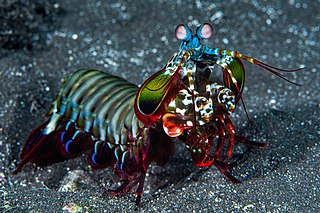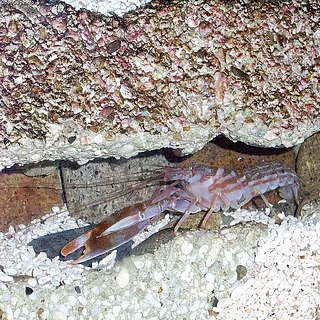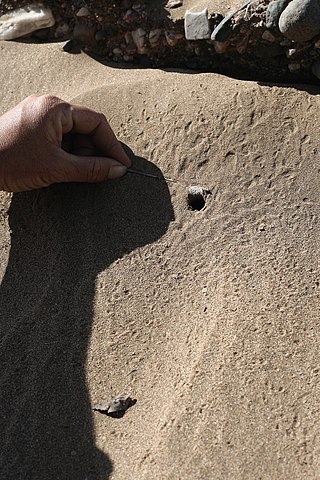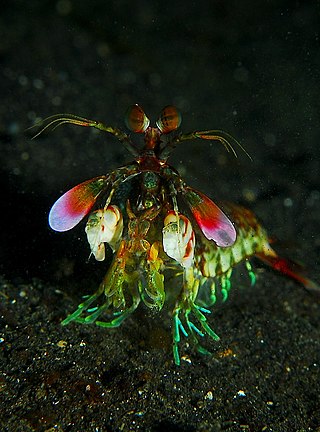
Mantis shrimp are carnivorous marine crustaceans of the order Stomatopoda. Stomatopods branched off from other members of the class Malacostraca around 340 million years ago. Mantis shrimp typically grow to around 10 cm (3.9 in) in length, while a few can reach up to 38 cm (15 in). A mantis shrimp's carapace covers only the rear part of the head and the first four segments of the thorax. Varieties range in colour from shades of brown to vivid colours, with more than 450 species of mantis shrimp known. They are among the most important predators in many shallow, tropical and subtropical marine habitats. However, despite being common, they are poorly understood, as many species spend most of their lives sheltering in burrows and holes.

Animal locomotion, in ethology, is any of a variety of methods that animals use to move from one place to another. Some modes of locomotion are (initially) self-propelled, e.g., running, swimming, jumping, flying, hopping, soaring and gliding. There are also many animal species that depend on their environment for transportation, a type of mobility called passive locomotion, e.g., sailing, kiting (spiders), rolling or riding other animals (phoresis).

Odontodactylus is a genus of mantis shrimp, the only genus in the family Odontodactylidae. Mantis shrimp of the genus Odontodactylus can not only detect circular polarisation of light, but can also detect polarised light reflecting off their telson and uropods.

Alpheidae is a family of caridean snapping shrimp, characterized by having asymmetrical claws, the larger of which is typically capable of producing a loud snapping sound. Other common names for animals in the group are pistol shrimp or alpheid shrimp.
Aptera Motors Corp. is an American crowd funded startup company based in Carlsbad, California with the mission "to create the most efficient transportation on the planet."

Terrestrial locomotion has evolved as animals adapted from aquatic to terrestrial environments. Locomotion on land raises different problems than that in water, with reduced friction being replaced by the increased effects of gravity.

Odontodactylus scyllarus, commonly known as the peacock mantis shrimp, harlequin mantis shrimp, painted mantis shrimp, clown mantis shrimp or rainbow mantis shrimp, is a large stomatopod native to the epipelagic seabed across the Indo-Pacific, ranging from Guam to East Africa, and as far South as Northern KwaZulu Natal in South Africa.

Ambush predators or sit-and-wait predators are carnivorous animals that capture or trap prey via stealth, luring or by strategies utilizing an element of surprise. Unlike pursuit predators, who chase to capture prey using sheer speed or endurance, ambush predators avoid fatigue by staying in concealment, waiting patiently for the prey to get near, before launching a sudden overwhelming attack that quickly incapacitates and captures the prey.

Agonistic behaviour is any social behaviour related to fighting. The term has broader meaning than aggressive behaviour because it includes threats, displays, retreats, placation, and conciliation. The term "agonistic behaviour" was first implemented by J.P Scott and Emil Fredericson in 1951 in their paper "The Causes of Fighting in Mice and Rats" in Physiological Zoology.Agonistic behaviour is seen in many animal species because resources including food, shelter, and mates are often limited.

Squilla mantis is a species of mantis shrimp found in shallow coastal areas of the Mediterranean Sea and the Eastern Atlantic Ocean: it is also known as "pacchero" or "canocchia". Its abundance has led to it being the only commercially fished mantis shrimp in the Mediterranean.
Rissoides desmaresti is a species of mantis shrimp native to the eastern Atlantic Ocean and Mediterranean Sea.

The wheel spider or golden wheel spider, is a huntsman spider native to the Namib Desert of Southern Africa. This spider should not be confused with Leucorchestris arenicola, a spider sharing the same common name as well as the same locale. The spider escapes parasitic pompilid wasps by flipping onto its side and cartwheeling down sand dunes at speeds of up to 44 turns per second.

Lysiosquillina maculata, the zebra mantis shrimp, striped mantis shrimp or razor mantis, is a species of mantis shrimp found across the Indo-Pacific region from East Africa to the Galápagos and Hawaiian Islands. At a length up to 40 cm, L. maculata is the largest mantis shrimp in the world. L. maculata may be distinguished from its congener L. sulcata by the greater number of teeth on the last segment of its raptorial claw, and by the colouration of the uropodal endopod, the distal half of which is dark in L. maculata but not in L. sulcata. A small artisanal fishery exists for this species.

Gonodactylus smithii, also known as the purple spot mantis shrimp or Smith's mantis shrimp, is a species of the smasher type of mantis shrimp. G. smithii are the first animals discovered to be capable of dynamic polarization vision. They are identified by their distinctive meral spots ranging from maroon to purple with a white ring, though those that inhabit depths below 10 meters tend to be colored maroon. They also have raptorial dactyles, specialized forelimbs that are pigmented green and red, and antennal scales that are yellow.

Crustaceans may pass through a number of larval and immature stages between hatching from their eggs and reaching their adult form. Each of the stages is separated by a moult, in which the hard exoskeleton is shed to allow the animal to grow. The larvae of crustaceans often bear little resemblance to the adult, and there are still cases where it is not known what larvae will grow into what adults. This is especially true of crustaceans which live as benthic adults, more-so than where the larvae are planktonic, and thereby easily caught.

Crustaceans belong to the subphylum Crustacea, and form a large, diverse group of arthropods including decapods, seed shrimp, branchiopods, fish lice, krill, remipedes, isopods, barnacles, copepods, amphipods and mantis shrimp. The crustacean group can be treated as a subphylum under the clade Mandibulata. It is now well accepted that the hexapods emerged deep in the Crustacean group, with the completed group referred to as Pancrustacea. The three classes Cephalocarida, Branchiopoda and Remipedia are more closely related to the hexapods than they are to any of the other crustaceans.

Nicholas Justin Marshall is a British-Australian neuroscientist-ecologist whose research focuses on decoding how animals use color to communicate. He is known for discovering the most complex animal visual system known of any organism. – that of the mantis shrimp, which has 12 color channels.

Acanthosquilla derijardi is a species of stomatopod crustacean. Its distribution is widespread throughout the Indo-West Pacific. The species was initially described by the American carcinologist Raymond B. Manning in 1970. Its junior synonym, A. sirindhorn, was named in 1995 in honor of Princess Sirindhorn of Thailand.

Gonodactylus chiragra is a medium to large mantis shrimp that is distributed widely throughout the West Indo-Pacific.
Hemisquilla californiensis is a species of mantis shrimp native to the northern Pacific.
















